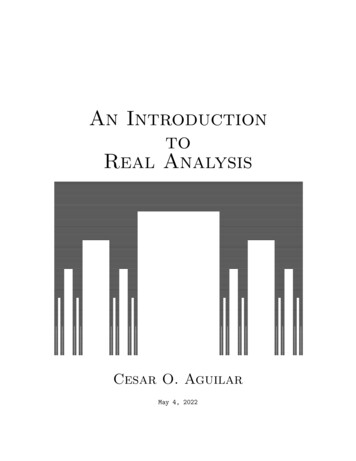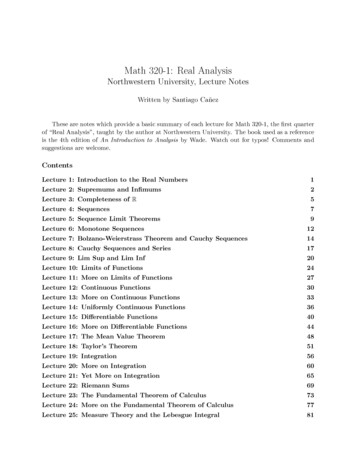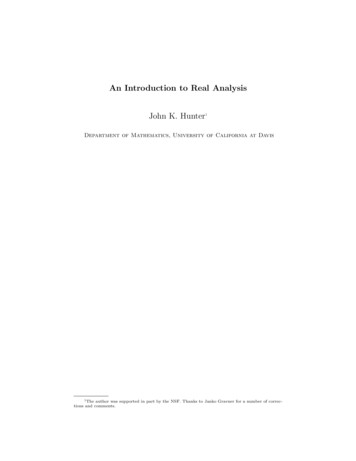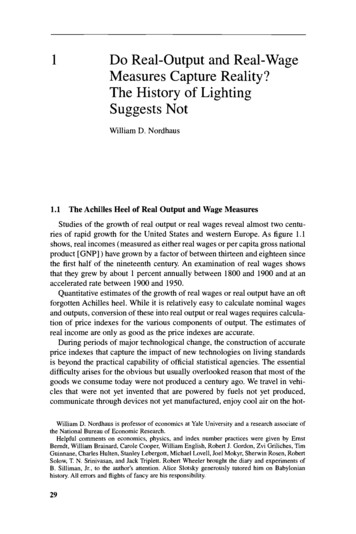
Transcription
An IntroductiontoReal AnalysisCesar O. AguilarMay 4, 2022
Contents1 Preliminaries11.1 Sets, Numbers, and Proofs . . . . . . . . . . . . . . . . .11.2 Mathematical Induction . . . . . . . . . . . . . . . . . .81.3 Functions . . . . . . . . . . . . . . . . . . . . . . . . . . 131.4 Countability . . . . . . . . . . . . . . . . . . . . . . . . . 192 The Real Numbers312.1 Introduction . . . . . . . . . . . . . . . . . . . . . . . . . 312.2 Algebraic and Order Properties . . . . . . . . . . . . . . 352.3 The Absolute Value . . . . . . . . . . . . . . . . . . . . . 392.4 The Completeness Axiom . . . . . . . . . . . . . . . . . 472.5 Applications of the Supremum . . . . . . . . . . . . . . . 582.6 Nested Interval Theorem . . . . . . . . . . . . . . . . . . 633 Sequences693.1 Limits of Sequences . . . . . . . . . . . . . . . . . . . . . 693.2 Limit Theorems . . . . . . . . . . . . . . . . . . . . . . . 823.3 Monotone Sequences . . . . . . . . . . . . . . . . . . . . 913.4 Bolzano-Weierstrass Theorem . . . . . . . . . . . . . . . 993.5 limsup and liminf . . . . . . . . . . . . . . . . . . . . . . 1063.6 Cauchy Sequences . . . . . . . . . . . . . . . . . . . . . . 1123
3.7 Infinite Series . . . . . . . . . . . . . . . . . . . . . . . . 1184 Limits of Functions1374.1 Limits of Functions . . . . . . . . . . . . . . . . . . . . . 1374.2 Limit Theorems . . . . . . . . . . . . . . . . . . . . . . . 1505 Continuity5.1 Continuous Functions . . . . . . . . . .5.2 Combinations of Continuous Functions5.3 Continuity on Closed Intervals . . . . .5.4 Uniform Continuity . . . . . . . . . . .157. 157. 163. 167. 1746 Differentiation1816.1 The Derivative . . . . . . . . . . . . . . . . . . . . . . . 1816.2 The Mean Value Theorem . . . . . . . . . . . . . . . . . 1916.3 Taylor’s Theorem . . . . . . . . . . . . . . . . . . . . . . 1967 Riemann Integration7.1 The Riemann Integral . . . . . . . . .7.2 Riemann Integrable Functions . . . . .7.3 The Fundamental Theorem of Calculus7.4 Riemann-Lebesgue Theorem . . . . . .8 Sequences of Functions8.1 Pointwise Convergence . . . . . . .8.2 Uniform Convergence . . . . . . . .8.3 Properties of Uniform Convergence8.4 Infinite Series of Functions . . . . .205. 205. 216. 223. 225.229. 230. 238. 245. 2559 Metric Spaces2679.1 Metric Spaces . . . . . . . . . . . . . . . . . . . . . . . . 267
9.29.39.49.59.6Sequences andContinuity . .CompletenessCompactnessFourier SeriesLimits. . . . . . . . . . . . .10 Multivariable Differential Calculus10.1 Differentiation . . . . . . . . . . . .10.2 Differentiation Rules and the MVT10.3 The Space of Linear Maps . . . . .10.4 Solutions to Differential Equations10.5 High-Order Derivatives . . . . . . .10.6 Taylor’s Theorem . . . . . . . . . .10.7 The Inverse Function Theorem . . .275286293305311.317. 317. 328. 334. 334. 334. 345. 348
PrefaceThe material in these notes constitute my personal notes that are usedin the course lectures for MATH 324 and 325 (Real Analysis I, II).You will find that the lectures and these notes are very closely aligned.The notes highlight the important ideas and examples that you shouldmaster as a student. You may find these notes useful if: you miss a lecture and need to know what was covered, you want to know what material you are expected to master, you want to know the level of difficulty of questions that youshould expect in a test, and you want to see more worked out examples in addition to thoseworked out in the lectures.If you find any typos or errors in these notes, no matter how small,please email me a short description (with a page number) of the typo/error.Suggestions and comments on how to improve the notes are also welcomed.Cesar O. AguilarSUNY Geneseo
1PreliminariesIn this short chapter, we will briefly review some basic set notation,proof methods, functions, and countability. The presentation of thesetopics is intentionally brief for two reasons: (1) the reader is likelyfamilar with these topics, and (2) we include only the necessary materialneeded to start doing real analysis.1.1Sets, Numbers, and ProofsLet S be a set. If x is an element of S then we write x S, otherwisewe write that x / S. A set A is called a subset of S if each element ofA is also an element of S, that is, if a A then also a S. To denotethat A is a subset of S we write A S.Now let A and B be subsets of S. If A B and B A then A andB are said to be equal and we write that A B. The union of A andB is the setA B {x S x A or x B}and the intersection of A and B is the setA B {x S x A and x B}.1
1.1. SETS, NUMBERS, AND PROOFSSAA BSBABA BFigure 1.1: Set intersection A B and union A BA graphical representation of set unions and intersections are shown inFigure 1.1.The empty set is the set that does not contain any elements andis denoted by . We note that S for any set S. The sets A and Bare disjoint if A B . The complement of A in S is the setS\A {x S x / A},in other words, S\A consists of the elements in S not contained in A.We sometimes use the shorter notation Ac for S\A when it is clear thatit is the complement of A relative to S.The Cartesian product of A and B, denoted by A B, is the setof ordered pairs (a, b) where a A and b B, in other words,A B {(a, b) a A, b B}.A partition of a set S is a set Π whose elements are subsets of Ssuch that Π does not contain the empty set, the union of the elementsof Π equals S, and any two distinct elements of Π are disjoint.Lastly, for any set S, the power set of S is the set of all subsets ofS, and is denoted by P(S).2
1.1. SETS, NUMBERS, AND PROOFSExample 1.1.1. Let A and B be subsets of a set S. Show that(A B)c Ac B c .Solution. We first show that (A B)c Ac B c . If x (A B)c thenby definition x / (A B) and therefore x / A and x / B. Thus, x Acand x B c , that is, x Ac B c .Now suppose that x Ac B c , that is, suppose that x Ac andx B c . Thus, x / A and x / B and thus x / (A B). By definition,x (A B)c and this proves that Ac B c (A B)c.We use the symbol N to denote the set of natural numbers, thatis,N {1, 2, 3, 4, . . .}.The set of integers is denoted by Z so thatZ {. . . , 3, 2, 1, 0, 1, 2, 3, . . .}.The set of rational numbers is denoted by pQ p, q Z, q 6 0 .qNotice that we have the following chain of set inclusions:N Z Q.We now review the most commonly used methods of proof. To thatend, recall that a logical statement is a declarative sentence that canbe unambiguously decided to be either true or false. A theorem isa logical statement that has been proved to be true using a sequenceof true statements and deductive reasoning. Many theorems are usually written as a conditional statement of the form “if P then Q” or3
1.1. SETS, NUMBERS, AND PROOFSsymbolically “P Q”. The statement P is called the hypothesisor assumption and Q is called the conclusion. Below are the maintechniques used to prove the statement “P Q”: Direct Proof : To prove the statement “P Q”, assume thatthe statement P is true and show by combining axioms, definitions, and earlier theorems that Q is true. This should be thefirst method you attempt. Mathematical Induction: Covered in Section 1.2. By Contraposition: Proving the statement “P Q” by proving the logically equivalent statement “not Q not P ”. Do notconfuse this with proof by contradiction. By Contradiction: To prove the statement “P Q” by contradiction, one assumes that “P Q” is false and then show thatsome contradiction results. Assuming that “P Q” is false isto assume that P is true and Q is false. Using these to latter assumptions, one attempts to derive at a contradiction of the form“R and not R”, where R is some statement. One disadvantagewith proof by contradiction is that the logical contradiction thatone is seeking “R and not R” is not known in advance so thatthe goal of the proof is unclear. Proof by contradiction frequentlygets confused with proof by contraposition in the following way(do not do this): To prove that “P Q”, assume that P is trueand suppose that Q is not true. After some work using only theassumption that Q is not true you show that P is not true andthus you say that there is a contradiction because you assumedthat P is true. What you have really done is proved the contrapositive statement. Thus, if you believe that you are proving a4
1.1. SETS, NUMBERS, AND PROOFSstatement by contradiction, take a close look at your proof to seeif what you have is a proof by contraposition.In the following example, we use both proof by contradiction andproof by contraposition.Example 1.1.2. Prove that if x and y are consecutive integers thenx y is odd.Solution. Assume that x and y are consecutive integers (i.e. assumeP ) and assume that x y is not odd (i.e. assume not Q). Since x yis not odd then x y 6 2n 1 for all integers n. However, since x andy are consecutive, and assuming without loss of generality that x y,we have that x y 2x 1. Thus, we have that x y 6 2n 1 for allintegers n and also that x y 2x 1. Since x is an integer we havereached a contradiction. Hence, if x and y are consecutive integers thenx y is odd.Now we prove the statement by contraposition. Without loss ofgenerality, suppose that x y. Assume that x y is even. Then thereexists an integer n such that x y 2n and therefore x 2n y.Consequently,y x y (2n y) 2(y n).Hence, since (y n) is an integer, y x 6 1 and consequently x and yare not consecutive integers.In general, if the statement “P Q” is true then the converseconditional statement “Q P ” is not necessarily true. For example,the converse conditional statement in Example 1.1.2 is “if x y isodd then x and y are consecutive integers” is easily shown to be false(e.g., x 2 and y 5). The conjoined statement “P Q andQ P ”, alternatively written as “P if and only if Q” or symbolically5
1.1. SETS, NUMBERS, AND PROOFS“P Q”, is called a biconditional statement. Thus, to prove thatthe biconditional statement “P Q” is true one must prove that both“P Q” and “Q P ” are true.Example 1.1.3. Let A, B, and C be subsets of a set S. Prove that(A B) C if and only if A C and B C.6
1.1. SETS, NUMBERS, AND PROOFSExercisesExercise 1.1.1. Let A and B be subsets of a set S. Show that A Bif and only if B c AcExercise 1.1.2. Find the power set of S {x, y, z, w}.Exercise 1.1.3. Let A {α1, α2 , α3 } and let B {β1 , β2}. FindA B.Exercise 1.1.4. Let x Z. Prove that if x2 is even then x is even. Donot use proof by contradiction.Exercise 1.1.5. Prove that if x and y are even natural numbers thenxy is even. Do not use proof by contradiction.Exercise 1.1.6. Prove that if x and y are rational numbers then x yis a rational number. Do not use proof by contradiction.Exercise 1.1.7. Let x and y be natural numbers. Prove that x and yare odd if and only if xy is odd. Do not use proof by contradiction.7
1.2. MATHEMATICAL INDUCTION1.2Mathematical InductionMathematical induction is a powerful proof technique that relies on thefollowing property of N.Axiom 1.2.1: Well-Ordering PrincipleEvery non-empty subset of N contains a smallest element.In other words, if S is a non-empty subset of N then there exists a Ssuch that a x for all x S. The smallest element of S is denotedby min(S). Thus, min(S) S and min(S) x for all x S. We nowstate and prove the principle of Mathematical Induction.Theorem 1.2.2: Mathematical InductionSuppose that S is a subset of N with the following properties:(i) 1 S(ii) If k S then also k 1 S.Then S N.Proof. Suppose that S is a subset of N with properties (i) and (ii) andlet T N\S. Proving that S N is equivalent to proving that T isthe empty set. Suppose then by contradiction that T is non-empty.By the well-ordering principle of N, T has a smallest element, say itis a T . Because S satisfies property (i) we know that 1 / T andtherefore a 1. Now since a is the least element of T , then a 1 S(we know that a 1 0 because a 1). But since S satisfies property(ii) then (a 1) 1 S, that is, a S. This is a contradiction becausewe cannot have both a T and a S. Thus, T is the empty set, and8
1.2. MATHEMATICAL INDUCTIONtherefore S N.Mathematical induction is frequently used to prove formulas or inequalities involving the natural numbers. For example, consider thevalidity of the formula1 2 3 · · · n 12 n(n 1)(1.1)where n N. In words, the identity (1.1) says that the sum of all theintegers from 1 to n equals 21 n(n 1). We use induction to show thatthis formula is true for all n N. Let S be the subset of N consistingof the natural numbers that satisfy (1.1), that is,S {n N 1 2 3 · · · n 21 n(n 1)}.If n 1 then12 n(n 1) 12 (1 1) 1.Thus, 12 n(n 1) is equal to the sum of all the integers from 1 to n 1.Hence, (1.1) is true when n 1 and thus 1 S. Now suppose thatsome k N satisfies (1.1), that is, suppose that k S. Then we maywrite that(1.2)1 2 · · · k 21 k(k 1).We will prove that the integer k 1 also satisfies (1.1). To that end,adding k 1 to both sides of (1.2) we obtain1 2 · · · k (k 1) 12 k(k 1) (k 1).Now notice that we can factor (k 1) from the right-hand side andthrough some algebraic steps we obtain that1 2 · · · k (k 1) 21 k(k 1) (k 1) (k 1)[ 12 k 1] 21 (k 1)(k 2).9
1.2. MATHEMATICAL INDUCTIONHence, (1.1) also holds for n k 1 and thus k 1 S. We havetherefore proved that S satisfies properties (i) and (ii), and thereforeby mathematical induction S N, or equivalently that (1.1) holds forall n N.Example 1.2.3. Use mathematical induction to show that 2n (n 1)!holds for all n N.Example 1.2.4. Let r 6 1 be a constant. Use mathematical inductionto show that1 rn 12n1 r r ··· r 1 rholds for all n N.Example 1.2.5 (Bernoulli’s inequality). Prove that if x 1 then(1 x)n 1 nx for all n N.Proof. The statement is trivial for n 1. Assume that for some k Nit holds that (1 x)k 1 kx. Since x 1 then x 1 0 andtherefore(1 x)k (1 x) (1 kx)(1 x) 1 (k 1)x kx2 1 (k 1)x.Therefore, (1 x)k 1 1 (k 1)x, and the proof is complete byinduction.There is another version of mathematical induction called the Principle of Strong Induction which we now state.10
1.2. MATHEMATICAL INDUCTIONTheorem 1.2.6: Strong InductionSuppose that S is a subset of N with the following properties:(i) 1 S(ii) If {1, 2, . . . , k} S then also k 1 S.Then S N.Do you notice the difference between induction and strong induction?It turns out that the two statements are equivalent, in other words, if Ssatisies either one of properties (i)-(ii) of induction or strong inductionthen we may conclude that S N. The upshot with strong inductionis that one is able to use the stronger condition that {1, 2, . . . , k} Sto prove that k 1 S.11
1.2. MATHEMATICAL INDUCTIONExercisesExercise 1.2.1. Prove that n 2n for all n N.Exercise 1.2.2. Prove that 2n n! for all n 4, n N.Exercise 1.2.3. Use induction to prove that if S has n elements thenP(S) has 2n elements. Hint: If S is a set with n 1 elements, forinstance S {x1, x2, . . . , xn, xn 1}, then argue that P(S) P(S̃) Twhere S̃ S\{xn 1} and T consists of subsets of S that contain xn 1.How many sets are in P(S̃) and how many are in T ? And what isP(S̃) T ? Explain carefully.12
1.3. FUNCTIONS1.3FunctionsLet A and B be sets. A function from A to B is a rule that assignsto each element x A one element y B. The set A is called thedomain of f and B is called the co-domain of f . We usually denotea function with the notation f : A B, and the assignment of x to yis written as y f (x). We also say that f is a mapping from A to B,or that f maps A into B. The element y assigned to x is called theimage of x under f . The range of f , denoted by f (A), is the setf (A) {y B x A, y f (x)}.In the above definition of f (A), we use the symbol as a short-hand for“there exsits”. By definition, f (A) B but in general we do not havethat f (A) B, in other words, the range of a function is generally astrict subset of the function’s co-domain.Example 1.3.1. Consider the mapping f : Q Z defined by(1,x 0f (x) 1, x 0.The image of x 1/2 under f is f (1/2) 1. The range of f isf (Q) {1, 1}.Example 1.3.2. Consider the function f : N P(N) defined byf (n) {1, 2, . . . , n}.The set S {2, 4, 6, 8, . . . , } of even numbers is an element of the codomain P(N) but is not in the range of f . As another example, the setN P(N) itself is not in the range of f .Function’s whose range is equal to it’s co-domain are given a specialname.13
1.3. FUNCTIONSDefinition 1.3.3: SurjectionA function f : A B is said to be a surjection if for any y Bthere exists x A such that f (x) y.In other words, f : A B is a surjection if f (A) B.Example 1.3.4. The function f : Q Q defined by f (x) x2 is nota surjection. For example, y 1 is clearly not in the range of f sincef (x) x2 6 1 for all x Q. On the other hand, y 12164 is in therange of f since f (11/8) 121. Is y 2 in the range of f ?64Example 1.3.5. Consider the function f : P(N) N defined byf (S) min(S).Prove that f is a surjection.Solution. To prove that f is a surjection, we must show that for anyelement y N (the co-domain), there exists S P(N) (the domain)such that f (S) y. Consider then an arbitrary y N. Let S {y}and thus clearly S P(N). Moreover, it is clear that min(S) y andthus f (S) min(S) y. This proves that f is a surjection.Notice that in Example 1.3.5, given any y N there are many setsS P(N) such that f (S) y. This leads us to the following definition.Definition 1.3.6: InjectionA function f : A B is said to be an injection if no two distinctelements of A are mapped to the same element in B, in other words,for any x1, x2 A, if x1 6 x2 then f (x1) 6 f (x2).14
1.3. FUNCTIONSIn other words, f is an injection if whenever f (x1) f (x2) then necessarily x1 x2.Example 1.3.7. The function f : Q Q defined by f (x) x2 is notan injection. For example, f ( 2) f (2) 4.Example 1.3.8. Consider again the function f : N P(N) definedbyf (n) {1, 2, . . . , n}.This function is an injection. Indeed, if f (n) f (m) then {1, 2, . . . , n} {1, 2, . . . , m} and therefore n m. Hence, whenever f (n) f (m) thennecessarily n m and this proves that f is an injection.Example 1.3.9. Consider the function f : P(N) N defined byf (S) min(S)Is f an injection?Example 1.3.10. Consider the function f : N N N defined byf (n) (2n2, n 1)Show that f is an injection.Definition 1.3.11: BijectionA function f : A B is said to be a bijection if it is a surjectionand an injection.Example 1.3.12. Suppose that f : P Q is an injection. Prove thatthe function f : P f (P ) defined by f (x) f (x) for x P is abijection.15
1.3. FUNCTIONSSolution. By construction, f is a surjection. If f (x) f (y) then f (x) f (y) and then x y since f is an injection. Thus, f is an injection andthis proves that f is a bijection.Example 1.3.13. Prove that f : Q\{0} Q\{0} defined by f ( pq ) is a bijection, where gcd(p, q) 1.qpSuppose that f : A B is a bijection and define the function g :B A as follows: for b B let g(b) be the (necessarily unique) elementin A such that f (g(b)) b. Notice that by definition, g(f (a)) a. Thefunction g is called the inverse of f and we write instead g f 1. Itis not hard to show that g is a bijection and that g 1 f .Given functions f : A B and g : B C, the composition of gand f is the function (g f ) : A C defined as (g f )(a) g(f (a)).Theorem 1.3.14If f : A B and g : B C are injections (surjections) then thecomposition (g f ) : A C is an injection (surjection).Proof. Assume that f : A B and g : B C are injections. Toprove that (g f ) is an injection, suppose that (g f )(x1) (g f )(x2).Then by definition of (g f ), it follows that g(f (x1)) g(f (x2)). Nowsince g is an injection then necessarily f (x1) f (x2) and since f is aninjection then necessarily x1 x2. Thus if (g f )(x1) (g f )(x2)then x1 x2 and this proves that (g f ) is an injection.Now suppose that f and g are surjections. To prove that (g f ) :A C is a surjection, let z C be arbitrary. Since g is a surjection,there exists y B such that g(y) z. Since f is a surjection, thereexists x A such that y f (x). Thus, for x A we have that(g f )(x) g(f (x)) g(y) z. Hence, for arbitrary z C there16
1.3. FUNCTIONSexists x A such that (g f )(x) z and this proves that (g f ) is asurjection.The following result is then an immediate application of Theorem 1.3.14and the definition of a bijection.Corollary 1.3.15The composition of two bijections is a bijection.17
1.3. FUNCTIONSExercisesExercise 1.3.1. Consider the function f : N Q defined as f (n) n1 .Is f an injection? Is f a surjection?Exercise 1.3.2. Consider the function f : N N N defined asf (n, m) nm. Is f an injection? Is f a surjection?Exercise 1.3.3. Consider the function f : Q Q defined as f (x) (x 2)(x 6). Is f an injection? If f a surjection?Exercise 1.3.4. Let f : N Z be the function defined as(n,if n is even,f (n) 2 (n 1) 2 , if n is odd.Prove that f is a bijection.Exercise 1.3.5. The sign of a rational number x Q is defined assgn(x) x/ x if x 6 0, where x is the absolute value of x, andsgn(0) 1. For example, sgn( 3) 1 and sgn(2) 1. Prove thatthe function f : Z { 1, 1} N defined asf (x) (sgn(x), x 1)is a bijection.18
1.4. COUNTABILITY1.4CountabilityA non-empty set S is said to be finite if there is a bijection from{1, 2, . . . , n} onto S for some n N. In this case, we say that Scontains n elements and we write S n. If S is not finite then we saythat S is infinite.Example 1.4.1. Let f : P Q be an injection. If P is an infinite setthen f (P ) is an infinite set.Solution. The proof is by contraposition. Suppose that f (P ) is afinite set containing n elements. Then there exists a bijection g :{1, 2, . . . , n} f (P ). The function f : P f (P ) defined as f (x) f (x) for x P is a bijection (Example 1.3.12) and therefore (f 1 g) :{1, 2, . . . , n} P is a bijection. Thus P is a finite set and completesthe proof.We now introduce the notion of a countable set.Definition 1.4.2: CountabilityLet S be a set.(i) The set S is countably infinite if there is a bijection fromN onto S.(ii) The set S is countable if S is either finite or countably infinite.(iii) The set S is uncountable if S is not countable.Roughly speaking, a set S is countable if the elements of S can belisted or enumerated in a systematic manner. To see how, suppose19
1.4. COUNTABILITYthat S is countably infinite and let f : N S be a bijection. Then theelements of S can be listed asS {f (1), f (2), f (3), f (4), . . .}.Hence, although sets have no predetermined order, the elements of acountable set can be ordered.Example 1.4.3. The set S of odd natural numbers is countable. Recallthat n N is an odd positive integer if n 2k 1 for some k N. Abijection f : N S from N to S is f (k) 2k 1. The function f canbe interpreted as a listing of the odd natural numbers in the naturalway:S {f (1), f (2), f (3), . . .} {1, 3, 5, . . .}.Example 1.4.4. The natural numbers S N are countable. A bijection f : N S is f (n) n, i.e., the identity mapping.Example 1.4.5. The set of integers Z is countable. A bijection f fromN to Z can be defined by listing the elements of Z as follows:N : 1 2 3 4 5 6 7 . .Z : 0 1 1 2 2 3 3 . . .To be more precise, f is the function(n,if n is even,f (n) 2 (n 1) 2 , if n is odd.It is left as an exercise to show that f is indeed a bijection.Example 1.4.6. The set N N is countable. There are many bijectionsfrom N to N N but a particularly interesting one is the function definedas follows. Consider the family of linesLk {(x, y) N N y x k 1}20
1.4. COUNTABILITYfor k N. There are k points on the line Lk , namely (j, k 1 j) for1 j k, and we say that (j, k 1 j) is the jth point on the line Lk .The point (x, y) N N is contained in the line Lk where k x y 1.Thus, one way to enumerate the points in N N is to assign to each(x, y) Lk the number ρ(x, y) obtained by adding all points on thelines L1, . . . , Lk 1 and adding the position of (x, y) on line Lk , namelyx. Thus,ρ(x, y) 1 2 . . . (k 1) x1 (k 1)k x21 (x y 2)(x y 1) x.2The function ρ is called the Cantor pairing function. Alternatively,we use a modified version of ρ which we call τ : N N N and definedas(ρ(x, y), if (x y 1) is odd,τ (x, y) ρ(y, x), if (x y 1) is even.We now find a formula for the inverse of τ which we call the Cantorsnake. To write down the formula for τ 1 , we first let for each n N!p 1 1 8(n 1)m floor2and we note that m 0 is the smallest integer such that 12 m(m 1) n.We then set p(n) n 21 m(m 1) a then((p(n), p(n) m 2), if m is evenτ 1 (n) ( p(n) m 2, p(n)), if m is odd.We note that the point (x, y) τ 1(n) is on the line Lk with k m 1.The range of τ 1 isτ 1(N) {(1, 1), (2, 1), (1, 2), (1, 3), (2, 2), (3, 1), . . .}.21
1.4. 73044471126715162829451234567894610Figure 1.2: The image of the Cantor snakeThe sequence of pairs (x, y) N N generated by τ 1 for 1 n 55are shown in Figure 1.2.Example 1.4.7. Suppose that f : T S is a bijection. Prove that Tis countable if and only if S is countable.Solution. Suppose that T is countable. Then by definition there existsa bijection g : N T . Since g and f are bijections, the compositefunction (f g) : N S is a bijection. Hence, S is countable.Now suppose that S is countable. Then by definition there existsa bijection h : N S. Since f is a bijection then the inverse functionf 1 : S T is also a bijection. Therefore, the composite function(f 1 h) : N T is a bijection. Thus, T is countable.As the following theorem states, countability, or lack thereof, can22
1.4. COUNTABILITYbe inherited via set inclusion.Theorem 1.4.8: Inheriting CountabilityLet S and T be sets and suppose that T S.(i) If S is countable then T is also countable.(ii) If T is uncountable then S is also uncountable.Proof. To prove (i), let S be a countable set and let f : S N bea bijection. Define the mapping f : T f (T ) by f (x) f (x). ByExample 1.3.12, f is a bijection. Therefore, since f (T ) is a subset ofN, and thus countable, then T is countable. The proof of (ii) is left asan exercise.Example 1.4.9. Let S be the set of odd natural numbers. In Example 1.4.3, we proved that the odd natural numbers are countable byexplicitly constructing a bijection from N to S. Alternatively, since Nis countable and S N then by Theorem 1.4.8 S is countable. Moregenerally, any subset of N is countable.If S is known to be a finite set then by Definition 1.4.2 S is countable,while if S is infinite then S may or may not be countable (we have yet toencounter an uncountable set but soon we will). To prove that a giveninfinite set S is countable we could use Theorem 1.4.8 if it is applicablebut otherwise we must use Definition 1.4.2, that is, we must show thatthere is a bijection from S to N, or equivalently from N to S. However,suppose that we can only prove the existence of a surjection f from Nto S. The problem might be that f is not an injection and thus not abijection. However, the fact that f is a surjection from N to S somehowsays that S is no “larger” than N and gives evidence that perhaps S is23
1.4. COUNTABILITYcountable. Could we use a surjection f : N S to construct a bijectiong : N S? Or, what if instead we had an injection g : S N; couldwe use g to construct a bijection f : S N? The following theoremsays that it is indeed possible to do both.Theorem 1.4.10: Countability RelaxationsLet S be a set.(i) If there exists an injection g : S N then S is countable.(ii) If there exists a surjection f : N S then S is countable.Proof. (i) Let g : S N be an injection. Then the function g̃ : S g(S) defined by g̃(s) g(s) for s S is a bijection. Since g(S) Nthen g(S) is countable. Therefore, S is countable also.(ii) Now let f : N S be a surjection. For s S let f 1(s) {n N f (n) s}. Since f is a surjection, f 1(s) is non-empty for eachs S. Consider the function h : S N defined by h(s) min f 1(s).Then f (h(s)) s for each s S. We claim that h is an injection.Indeed, if h(s) h(t) then f (h(s)) f (h(t)) and thus s t, and theclaim is proved. Thus, h is an injection and then by (i) we concludethat S is countable.We must be careful when using Theorem 1.4.10; if f : N S isknown to be an injection then we cannot conclude that S is countableand similarly if f : S N is known to be a surjection then we cannotconclude that S is countable.Example 1.4.11. In this example we will prove that the union ofcountable sets is countable. Hence, suppose that A and B are countable. By definition, there exist bijections f : N A and g : N B.24
1.4. COUNTABILITYConsider the function h : N A B defined as follows:(f ((n 1)/2), if n is odd,h(n) g(n/2),if n is even.We claim that h is a surjection (Loosely speaking, if A {a1,
gets confused with proof by contraposition in the following way (do not do this): To prove that "P Q", assume that P is true and suppose that Qis not true. After some work using onlythe assumption that Qis not true you show that P is not true and thus you say that there is a contradiction because you assumed that P is true.











